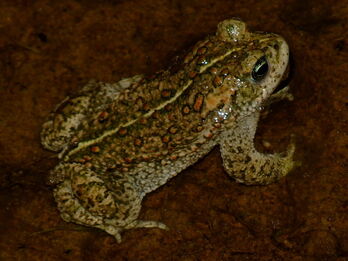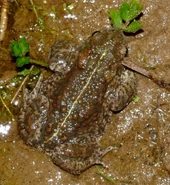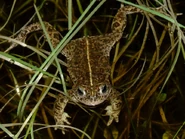
Natterjack Toad - Daniel Kane
The Natterjack Toad (Bufo calamita) is a toad native to sandy and heathland areas of Northern Europe. Adults are 60 – 70 mm in length and are distinguished from the common toad by a yellow line down the middle of the back. They have relatively long legs, and this gives them a distinctive gait, contrasting with the hopping movement of many other toad species.
Natterjacks have a very loud and distinctive mating call, amplified by the single vocal sack found under the chin of the male animal. This call can be hear over half a mile away.
Life history[]
This toad lives for up to 15 years and feeds on insects, worms and small reptiles. At night it moves along open terrains with very sparse vegetation and in loose sand the tracks can often be seen. They move along considerable distances each night, which enables the species to colonize new habitats very quickly.
In winter they burrow down 1-2 ft into the sand at the bottom of a pool of water before emerging for the spring.
Reproduction[]
The Natterjack Toad spawns between the end of April and July, laying 'strings' of eggs in shallow pools about 1-2 metres long, unlike a common toad the strands only have a single row of black eggs. The loud mating calls are important because the Natterjack Toad is often present in low numbers so it is important that the genders/sexes can find each other.
The pools need to have a very slight slope with a sparse vegetation on the banks and in the water. These are very often temporary pools and sometimes the larvae die when the pools dry out. The Natterjack however compensates for that risk by mating a few times each summer and the age of the juveniles can vary from a month to 3 months in September. It appears that the early breeders are not the same individuals as the toads that reproduce later in the season.
Distribution[]
- Ireland
This toad has been recorded in breeding sites in Counties Kerry and Wexford. It is native to Ireland.
Conservation[]
- In the UK this species is one of only three amphibians protected under the national Biodiversity Action Plan. The reason for the threatened status of this organism is: (a) loss of habitat from human overpopulation, (b) reduction in habitable coast from construction of dykes and seawalls, and (c) acidification of aquatic habitat from acid rain and other pollution factors. The toad's sand-dune habitat is protected by National Nature Reserves in England (at Ainsdale and North Walney) and in Scotland (at Caerlaverock).
Videos[]

Hunt for the Natterjack Toad!


